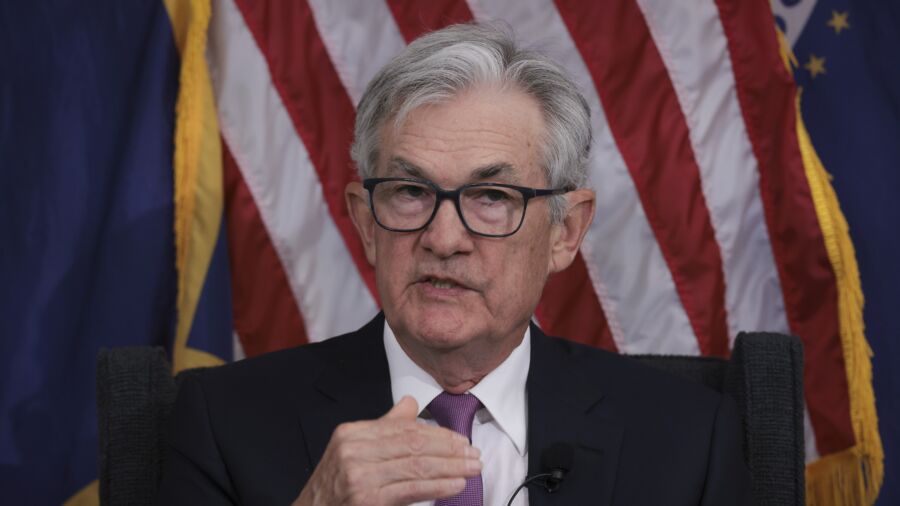The Federal Reserve’s policy rate might not need to rise as much amid tighter credit conditions stemming from the banking turmoil, Fed Chair Jerome Powell said during a panel discussion.
Speaking at the Perspectives on Monetary Policy panel at the Thomas Laubach Research Conference on May 19, Powell explained that the central bank’s financial stability tools had calmed the volatility in the banking system. However, at the same time, the latest developments in the sector, notably the tightening of credit standards, could weigh on economic growth, hiring, and inflation.
As a result, Powell, who appeared alongside former Fed Chair Ben Bernanke, conceded that the benchmark Fed funds rate might not need “to rise as much” to achieve its inflation objectives.
At the Federal Open Market Committee (FOMC) policy meeting and during the press conference this month, Powell hinted at a coming rate hike pause after raising rates for the 10th consecutive time.
Powell reiterated his position that inflation is still too high, and many people are “experiencing high inflation for the first time in their lives.”
“It’s not a headline to say that they really don’t like it,” he said. “We think that failure to get inflation down would, would not only prolong the pain but also increase ultimately the social costs of getting back to price stability, causing even greater harm to families and businesses, and we aim to avoid that by remaining steadfast in pursuit of our goals.”
The Cleveland Fed Bank Inflation Nowcasting model anticipates the May annual consumer price index will ease to 4.1 percent and rise 0.2 percent month-over-month.
To Pause or Not to Pause
In recent days, there has been some disagreement on the path of interest rates.
Dallas Fed Bank President Lorie Logan stated at a Texas Bankers Association on May 18 that the latest economic data do not justify hitting the pause button on rate hikes.

“After raising the target range for the federal funds rate at each of the last 10 FOMC meetings, we have made some progress,” Logan said in a prepared speech. “The data in coming weeks could yet show that it is appropriate to skip a meeting. As of today, though, we aren’t there yet.”
Loretta Mester, president of the Cleveland Fed Bank, suggested that rates will stay high and could venture higher based on the current data.
“The approach I’m taking is that I would like the policy rate to get to a point where, when I’m thinking about what would the next policy change be, I want it to be equally a potential increase versus a decrease,” Mester told the Global Interdependence Center in Ireland on May 16.
“When we get the policy to that rate, I think we’re going to be holding for a while in order to make sure that the interest rate is coming back down. So I don’t put it in terms of a pause; I put it in terms of a hold. Have we gotten to that rate yet? At this point, given the data we’ve gotten so far, I would say no.”
Fed Governor Philip Jefferson, whom President Joe Biden recently nominated to serve as vice chair, is bracing for more impact from the Fed’s rate hikes, warning of potential “downside risks.”
He agreed that the U.S. economy has “slowed considerably,” adding that he expects job growth to slow and the unemployment rate to climb over time.
“History shows that monetary policy works with long and variable lags and that a year is not a long enough period for demand to feel the full effect of higher interest rates,” Jefferson said at the 2023 International Insurance Forum. “There is considerable uncertainty about the magnitude of the impact on household spending and business investment, and this uncertainty complicates economic outlook forecasts.”
The Atlanta Fed Bank GDPNow model estimates second-quarter economic growth could be 2.9 percent.
But while there is a division at the central bank over interest rates, the futures market anticipates a pause at next month’s policy meeting. According to the CME FedWatch Tool, most investors expect the Fed to leave rates in the 5.00 and 5.25 percent range and could cut rates as early as November.
More Supply Shocks in the Future?
Powell agreed that the U.S. economy could witness more supply shocks in the future, but it might be challenging to forecast with confidence.
He listed the various supply shocks in recent years, such as labor, energy and non-energy commodities, and global supply chain disruptions.
But policymakers could use a strategy of identifying “the factors that we think can lead to further negative supply shocks,” Powell noted.
“For policymakers, the bottom line is that central banks will continue to be responsible for providing price stability, and that will require us to navigate whatever additional supply shocks do occur,” the Fed chairman said. “What a central bank can do is control inflation. And that is true over time, even in the presence of supply shocks should they come.”
Various metrics show that international supply chains have drastically improved from a year ago.
The New York Fed Bank’s Global Supply Chain Pressure Index (GSCPI)—which was established to “capture supply chain disruptions using a range of indicators”—suggests conditions have normalized as it turned negative in February for the first time since August 2019.
GEP Worldwide, a consultancy and software firm, reported through its Global Supply Chain Volatility Index that supply chains have seen a considerable reduction in volatility. The index—which tracks inventories, backlogs, supply chain shortages, and transportation costs—dipped below zero in April 2024.
“After months of companies aggressively de-stocking, there is now excess capacity in the world’s supply chains, providing buyers with greater leverage to extract favorable prices and terms for the second half of 2023 and into 2024,” said Volker Roelofsen, vice president of supply chain consulting at GEP, in a statement.
Although supply-chain congestion ticked higher at the end of March, Goldman Sachs noted in a report that bottlenecks have nearly returned to pre-crisis levels.
“Labor and equipment availability is improving alongside demand moderation,” bank researchers wrote.
From The Epoch Times

